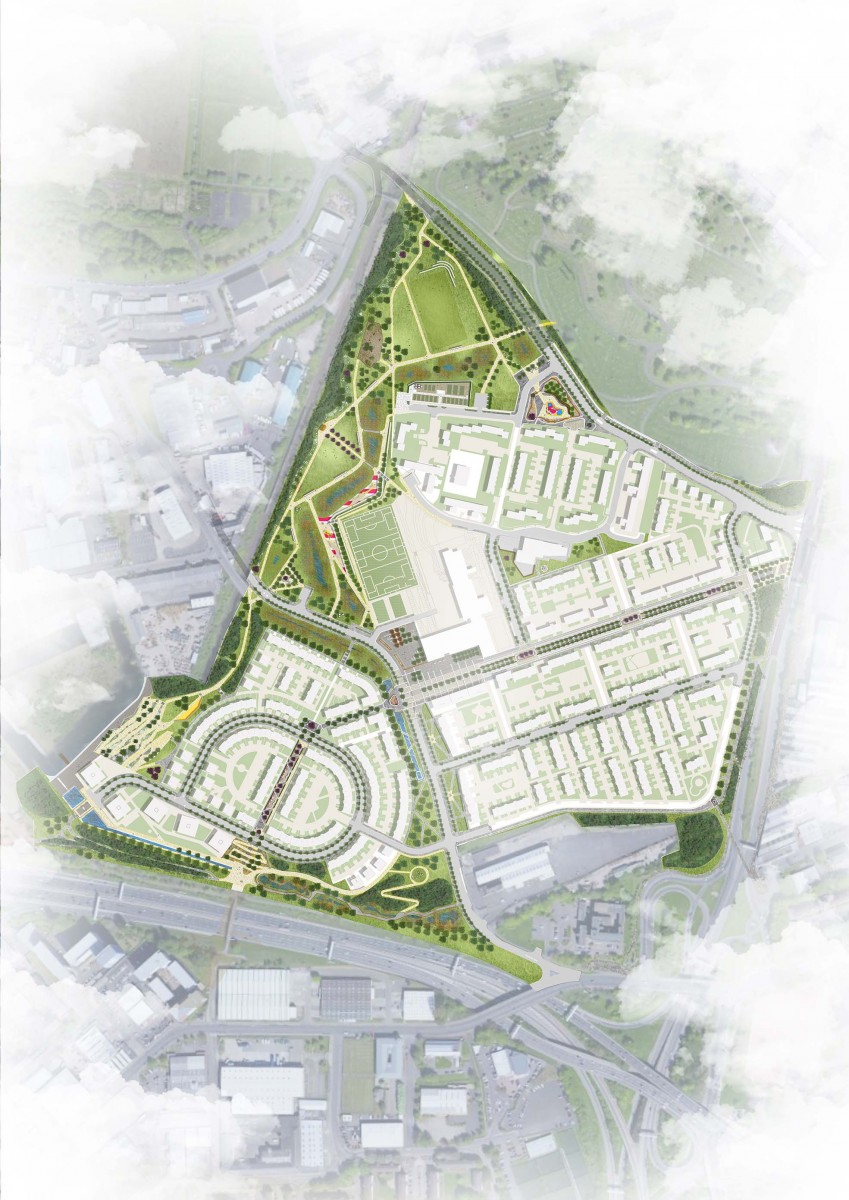Project showcase
Sighthill Transformational Regeneration Masterplan, Glasgow - Glasgow City Council, Keepmoat Homes Scotland with LDA Design

Please enter the project name:
Sighthill Transformational Regeneration Masterplan
Who is the developer/client of the project?
Advanced Infrastructure Project Client: Glasgow City Council
Residential Project Client: Keepmoat Homes Scotland
Describe the context of this project and the point it has reached in its development in 250 words max. When is the project expected to complete? Please upload a masterplan drawing that best describes the project in its location
The Sighthill neighbourhood has long had a strong community, let down by major road severance, poor amenities and low-quality housing built to last just 40 years. In the 1960s, its ten towers, on the edges of Glasgow city centre, were home to 7,500 people. Fast-forward twenty years, and Sighthill experienced high levels of drug use and crime.
Demolition began in the noughties and the last block came down in 2016. Glasgow City Council was determined that what came next gave residents a much better deal.
LDA Design’s landscape-led masterplan for Sighthill will create a mix of 850 new homes, and educational and community facilities, a ten-minute walk from Glasgow’s centre. Each space and street will be distinctive.
Ending the estate’s isolation and plugging it into the city and its job market was critical. A new ‘green bridge’ spans the M8 motorway, and the masterplan creates a web of green routes making travelling by bike or on foot easier.
Central to the vision was the development of advanced community infrastructure before the occupation of homes, ensuring that a useable neighbourhood was available to residents from the first. The community campus, including a new school and sports facilities has been in operation since 2020. This summer, extensive parklands will open – 30 of 48hectares available is green infrastructure.
The first housing completes in autumn 2021, with phases through to 2027. The build programme has been carefully considered to provide a strong sense of place throughout with temporary uses providing early tangible benefits.
What do you see as the greatest success of this project to date? How has it made a promising start on the journey to its completion? 250 words max. Please upload an image of the project to support your statement
Sighthill is the UK’s largest regeneration project outside of London. What makes it exciting is that at its heart is an outstanding green and blue natural network. Quality green space is scarce in Glasgow and with its industrial heritage Sighthill had next to nothing, so this is a step-change at scale. When we spoke to residents, access to green space topped their wish list.
Our approach was development, not erasure. So, we asked local people about their lived experiences. They spoke of playing on Jack’s Mountain (a slag heap) and in Curling Ponds, and of The Cuddies Standing Stones. We drew on these memories when shaping the landscape.
Anyone living here now will have access to woodlands and wetlands, allotments and a village green. We moved the Stones to a better location and reimagined Jack’s Mountain as terraced canal-side banks providing access to the waterfront. Play is prioritised. SuDS feed into a ‘Smart Canal’ and are a city-wide prototype.
This rich natural network has gone in first creating a real sense of place. This is the opposite of space leftover between buildings: it is central to quality of life. And it stems from focussing on people and what an inclusive community – old and new – needs.
Sighthill has required a phased construction programme, including the decant of two schools and working around 250 existing homes on site and educational campuses operational throughout.
Extensive public engagement and study shaped a framework that ensured existing communities were not displaced during construction.

How are you responding to changing demographics, behaviours, market context, policy, transport habits and the climate crisis since winning planning? What is your sustainability strategy and how are you mitigating carbon use and construction pollution? 250 words max. Please attach images, drawings or reports that support your statement
Landscape creates places where people belong. It can be the driver to tackling multiple issues such as social justice, inclusion, health and wellbeing, education and climate breakdown. LDA Design’s masterplan was shaped by measures that enhance technical performance, as well as social and environmental measures necessary to create a sustainable, maintainable, and future-proofed new community.
Our design creates a space in which people and nature can thrive by providing high-quality green space, making active travel the easy and natural choice, creating places for social gatherings and interaction, designing out crime and improving air quality.
Streets are integrated with SuDS provision and richly planted to provide recreation, education and biodiversity opportunities. Fully accessible routes, local facilities and spaces designed to foster interaction help to mitigate against loneliness, particularly amongst the elderly, Scotland’s fastest growing demographic.
Our approach to project delivery aims to minimise impacts on the built and natural environments, prevent disturbance and pollution, and protect the public and the workforce. Measures include use of locally harvested timber from sustainably managed forests; building placement reducing the need to import or export materials and arisings; eco stop-start ignitions on plant equipment to reduce carbon emissions and trialling the use of electric small plant. Detailed paving parameters reduced waste offcuts and existing road bases were reused in new road construction.
Carbon use is mitigated with suitable mass tree planting and innovative techniques such as use of a volcanic soil improver, an industrial by-product sourced locally, to improve soil quality and capture carbon.
Please share any figures on how the project is making a positive environmental, social and economic impact. Data or reports, article references or media clippings may also be attached to support your argument. 250 words max.
- 48 hectares of city centre land were brought back into safe public use through extensive remediation of the site, the ground having suffered industrial contamination. 30ha of this is new green infrastructure.
- 4,120 new trees of at least semi-mature size have been planted across the site, varying in size to ensure both instant impact and longevity. For bio-resilience, a wide range of tree species has been chosen and even main avenues feature mixed species to guard against potential catastrophic species failure in future.
- The site has capacity to retain 100% of surface water through an extensive sustainable drainage system. This SuDS strategy includes a pioneering ‘Smart Canal’ drainage system, which allows the canal’s water levels to be controlled mechanically and digitally. It is the largest example of an integrated SuDS system in the west of Scotland, and it has unlocked development potential for hectares of waterside frontage, which people love.
- 25% of housing is social rental, all tenure-blind, with every resident having equity of access to facilities. Housing mix was considered to encourage generational moves within a development - important in terms of creating and sustaining a strong sense of community in a neighbourhood.
- Local businesses will be encouraged to take on-site commercial units, possibly benefiting from council subsides initially. Retail will provide additional job opportunities.
- Main and subcontractors are committed to providing community benefits, including an on-site training facility for young people offering them the opportunity to begin a career in construction.
Festival of Pineapples
24-26 February 2026
Pineapples prize giving night
April
Pineapples at Festival of Place
10 June 2026
© The Pineapples - Tweak Ltd. 124 City Road, London, EC1V 2NX. Tel: 020 3326 7238




